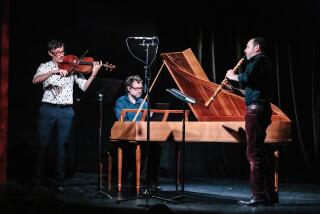MUSIC REVIEW : Guarneri Quartet Is Mostly Masterful at Barclay
IRVINE — The best moments of the Guarneri Quartet’s concert Wednesday night were when the group wasn’t even there.
That is, when the musicians seemed to disappear entirely into the music. There were many such moments Wednesday, illustrating the group’s effortless manner of execution and its self-effacing approach to performance.
But there were times too when the Guarneri wasn’t so transparent, when the musicians’ personalities seemed more in view, when their own ideas seemed to peek out through the notes, times when the “i” word--interpretation--hung in the air above the music. These were good, too. Only not as good.
The Guarneri--Arnold Steinhardt and John Dalley, violins; Michael Tree, viola; David Soyer, cello--is the dean of string quartets, having gone since its inception in 1964 without any personnel changes. With more than 2,100 concerts behind them, these musicians often play as if reading each others’ minds. Wednesday, this resulted in perfect fluidity on the one hand and something close to fussiness on the other.
Ernst von Dohnanyi’s rarely encountered Second String Quartet in D-flat major was the centerpiece of the program, otherwise devoted to standards. It is a tightly constructed work in a Straussian manner tinged with Hungarian. Its eventful structure initially outlines a fervent, episodic history; it spends its second half mulling over what has happened.
Negotiating its tricky tempo changes with apparent ease, executing its long-limbed lyricism with brisk urgency, the quartet offered a dramatically compact reading. Given the opportunity to expand on an emotional utterance, or to shine in a passing detail, the players opted for restraint and overall movement.
Before a packed Irvine Barclay Theatre, including a sizable contingent seated onstage, the Guarneri opened with Haydn’s ‘Lark’ Quartet, Opus 64, No. 5, wonderfully avoiding the pitfalls of preciousness while steering clear of overstatement. This was a robust, fully characterized performance but also a thoroughly focused and never romanticized one.
With Schubert’s “Death and the Maiden” Quartet after the intermission came the ensemble’s most self-conscious playing. The fluctuating tempo scheme of the Allegro seemed overcalculated, the smooth accentuation of the Scherzo seemed studied, the polished projection of the soaring lyricism seemed too pat. Surprisingly, the music could have benefited from less equanimity between the players: These melodies call for protagonists, not partners.
Still, it was impossible not to admire a great deal of this performance, particularly the group’s account of the variations movement in which the composer’s busy obbligatos and accompaniments were projected with enchanting detail and warmth. The fugue finale of Haydn’s Opus 20, No. 5 was the encore.
More to Read
The biggest entertainment stories
Get our big stories about Hollywood, film, television, music, arts, culture and more right in your inbox as soon as they publish.
You may occasionally receive promotional content from the Los Angeles Times.










